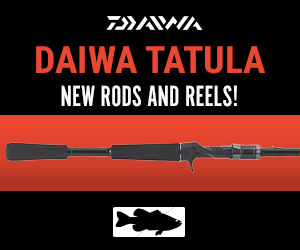|
Set to Destroy! Okuma’s Hakai Might Just Change How You View the
Brand’s Baitcasters Entirely (continued)
  Casting:
To help improve casting feel and overall performance Okuma engineers worked
together with the spool tuning company, Dream Tackle. Their goal was to help
take the Hakai’s castability to the next level. We asked John to describe the
collaboration with Dream Tackle. Casting:
To help improve casting feel and overall performance Okuma engineers worked
together with the spool tuning company, Dream Tackle. Their goal was to help
take the Hakai’s castability to the next level. We asked John to describe the
collaboration with Dream Tackle.

The cast control is magnetic and
externally adjustable
“Very much like our Makaira
story on the saltwater side, Okuma made the effort to collaborate with industry
experts such as Dream Tackle to try and build a better mouse trap,” John
explained. “Okuma engineers and Dream Tackle were involved on most design
elements of the Hakai but were Dream Tackle really brought the expertise was in
the design construction and concepts of the Flite Spool and Flite Shaft. These
are two key elements of this reel that provide weight reduction and enhanced
performance for castability, allowing the Hakai to stand out from other reels in
this price class.”

Okuma isn't shy about the fact
they worked with Dream Tackle to create the new Flite Spool. Notice the small
SUS balls embedded at both ends of the spool
The Flite Spool is Okuma’s
fancy marketing name for this tuned spool, which has a 33 mm outer diameter, and
a 0.4mm thickness. The entire spool assembly weighs 9.7g (measured) which is
impressive for a spool of this diameter that is not heavily ported.

The spool weighed in at 9.7g in
the lab
Where things really start to
get interesting is when we look at the spool’s shaft. The Flite Shaft is a
patented design that features a hollow center. Why make the shaft hollow?
Doesn’t this decrease rigidity? Okuma believes that the steel used to construct
the shaft is strong enough to handle anything that is thrown at the Hakai, and
this design enables the company to press two precision SUS balls, one on either
end of the shaft.
So, what does this Okuma and
Dream Tackle design mean in terms of actual casting performance? Simply put this
is not only the most unique feeling Okuma baitcaster to date, but also the best
casting one as well.

The Hakai startup on cast is quick
and efficient. It took me a little bit to dial in the settings but once I did
the reel really impresses on both long distance casts as well as accuracy in
shorter strategic bait placements
Stainless steel spool shafts
have long been the industry standard because the material is durable, stiff and
corrosion resistant. The stiffness is important to ensure smooth operation
during both casts, and when the spool is under the pressure from fighting fish,
and especially with low-stretch lines and dialed up drags. After fishing the
Hakai for two months I found the reel continued to hold up well in this respect
and asked how the company addressed this with the hollow shaft design. John
explained:
“Okuma’s design goal was how
do we keep rigidity and overall strength, but shave weight to help the overall
target of a lightweight reel. The development of the stainless-steel hollow
Flite Shaft provided the best all-around design. It reduces weight and retains
rigidity. This design had to be thoroughly tested to ensure that strength would
not be compromised, in the end, we feel that we have a very unique design that
not only enhances performance it also separates the Hakai from all others in the
market. The addition of the floating balls at the end of the shaft is an added
bonus as this is a feature that not only helps castability, but is also very
innovative.”

While the Hakai is great at
launching heavy baits it also excels across the weight range
The startup on the Hakai is
very quick and effortless, and early on I found I had to dial up the magnetic
cast controls a bit to manage just how quickly line peeled off the spool during
the first few seconds of each cast. This quick startup not only makes the Hakai
a great long-distance caster but also a very accurate, and effortless, pitching
reel. Even lightweight 1/16 baits were easy to cast with the Hakai once I had
the cast control settings dialed in.
I feel like Okuma and Dream
Tackle have really accomplished something quite interesting with this new
design. The SUS balls may seem gimmicky, but the performance is real, and so is
the effect on how the reel feels each time you cast it. When I went back to
compare the Hakai with older Okuma Helios reels they felt so much less fluid
during casts.

Shorter pitches are effortless
After about six months of use
I did notice that the casting distance did seem to drop a little bit, and the
reel didn’t feel quite as effortless to cast as the day it came out of the box.
This is where the Flite Shaft does require a quick bit of maintenance. The two
balls at the end of the shaft can use a drop of fine oil to restore original
performance as well as increase overall longevity.

After extended use I did find it
beneficial to add a drop of oil to the SUS balls
How often anglers lubricate
the SUS balls depends on usage but after speaking to John he agreed that reels
that are in operation on a regular basis could be oiled twice a year, while
normal use would only require this probably once a year. This quick bit of
maintenance only takes minutes and helps restore original casting performance.

The cast control system is really
easy to tune with the externally adjustable dial
Next Section: A beautifully machined brass
maingear  |

























